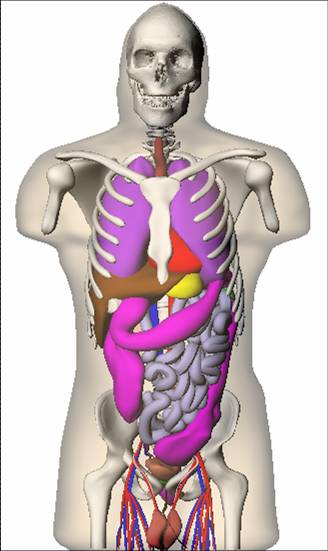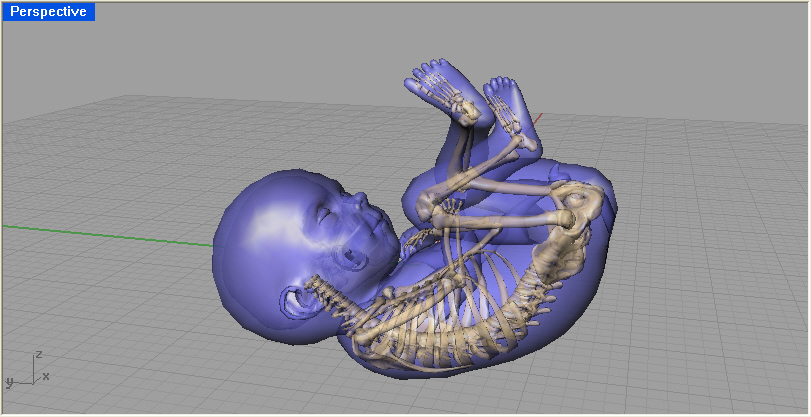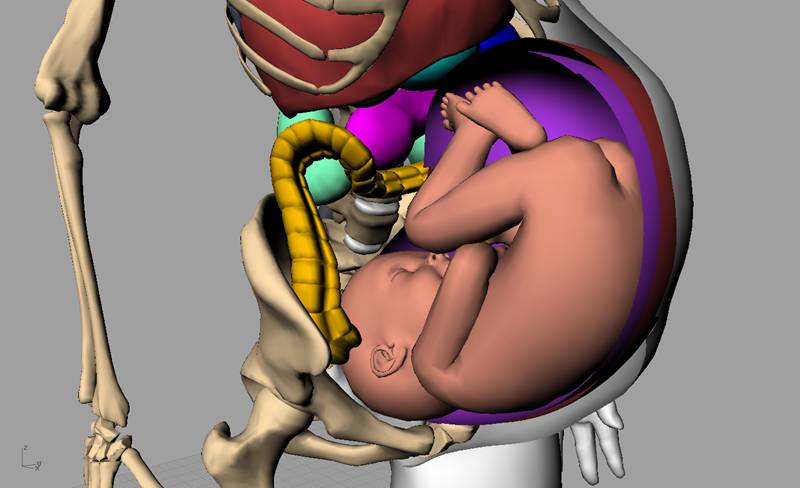THE RADAR SITE:
RADAR INFORMATION:
Overview
News and Events
RADAR SERVICES:
Training Courses
Consulting
Software
RADAR MEMBERS
RADAR Home Page
RADAR RESOURCES:
RADAR ON-LINE DATA:
On-Line Decay Data
On-Line Kinetic Data
On-Line Model Dose Factors
INTERNAL SOURCES:
Occupational Dose Factors
Nuclear Medicine:
Therapy
EXTERNAL SOURCES:
External Point Source
Beta Dose to Skin
Immersion in Air
Ground Contamination
Medical Sources
VARSKIN code
RADAR SOFTWARE
DOSE-RELATED LITERATURE
MEDICAL PROCEDURE DOSE CALCULATOR AND RISK LANGUAGE GENERATOR
RADAR DOCUMENTS:
System Overview
Internal Dose System
External Dose System
Decay Data
Kinetic Data
Phantoms
Risk Models
RADAR - Available Phantoms
You want phantoms, we got phantoms. RADAR has developed an entire new generation of human body models, to replace the 'stylized' ORNL phantoms of the 1980s and 1990s. The older models look like this.....:
RADAR's totally cool new ones that look like this.....:

Fetus don't fail me now.....


Our new phantoms have been used with the OLINDA/EXM software code to develop two compendia of dose estimates for radiopharmaceuticals, one for adults and pediatric subjects, and one for pregnant women at different stages of gestation.
Dr. George Xu of Rensselaer Polytechnic Institute has organized a site which compiles and distributes information about the many
new phantoms that are being developed by a number of groups, called the Consortium of Computational Human Phantoms (CCHP)
History of Phantom Development
For those of you who may have skipped over the initial overview of the
system, and donít know, a phantom in the context of internal
and external dose assessment is a mathematical representation of the
human body used to calculate the Dose Factors (DFs) that
we need to convert disintegrations in some source region to absorbed
dose in a target region. To model anything - the human body, a cell,
a city, etc. - one always starts with a sphere, because itís
so simple mathematically. A great book on the subject of modeling
was actually called "Consider a Spherical Cow" by John Harte (see web page). In the
late 1950ís we did have a spherical human, with lots of little
spherical organs. Easy to calculate numbers with, but not too
realistic. Then, in about 1975, a phantom was developed that was
supposed to represent an average adult worker of the Western
Hemisphere, based on the so-called (and completely politically
incorrect) Reference Man, so dubbed by the International Commission
on Radiological Protection (ICRP). The ICRP didnít design the
phantom, they just collected the data on the typical sizes of
peopleís bodies and their organs, and two guys at Oak Ridge
National Laboratory named Fisher and Snyder (the latter being Walt
Snyder, who basically founded and ran the MIRD Committee for many
years) designed a phantom based on Reference Man and ran a Monte
Carlo code whose results were used to calculate DFs for all the
organs in this phantom irradiating all the others (which,
interestingly, contained both male and female organs - a mind
bender, ainít it?).
OK, this did well for some time in calculating doses to adults, but in nuclear medicine as well as other applications we quickly found the need for phantoms representing other people. In 1987, Cristy and Eckerman published a very important work in which they described six phantoms representing children and adults. These six phantoms were designated as a Newborn, One-Year-Old, Five-Year-Old, Ten-Year-Old, Fifteen-Year-Old and an Adult. The adult was very similar to the Fisher-Snyder phantom, but had some minor modifications, and included some organs that the Fisher-Snyder phantom did not. All of the phantoms had both male and female organs. The age designations were meant to be approximate - Cristy and Eckerman researched the changes of organ size, position, and composition with age and, like the Reference Man document, catalogued what they felt were the appropriate values to use as averages for that age. Of course some children grow faster or slower than others - one can envision a 5-yr-old who is as big as the 10-yr-old phantom; in this case, the 10-yr-old phantom should probably be used, as what we are after is energy absorbed per unit mass (dose), and the important issue is probably mass. In any case, the idea was to give a set of phantoms that would span the size of people from infancy to adultery, I mean adulthood, and which could be used to calculate dose estimates for a range of people of different sizes.
By this point in our presentation about half of you are probably upset, because we are not giving enough consideration to the stronger sex. Women were somewhat slighted in all of this, as they were slighted in the workplace for so long. Although the Fisher-Snyder and Cristy-Eckerman phantoms had female organs, they were pretty much built around the average male for that age. The Cristy-Eckerman 15-year-old phantom was used for many years as a surrogate for an adult female, but who wants to have a surrogate representative? In 1995, Stabin and colleagues put out a document similar to the Cristy-Eckerman document, but with a series of 4 phantoms representing the adult female - the first was just a standard adult female (with several notable differences from the Cristy-Eckerman 15-year-old phantom) and the other three represented the woman at various stages of gestation, as dose to the fetus is such an important issue in both nuclear medicine and other areas.
So as of this date, one could argue, we have a more or less complete Ďfamilyí of phantoms - just like a real household - kids running around screaming, dad sitting there doing nothing, several pregnant women (all right, a strange household perhaps, but is yours, like, perfectly normal?). If you want to see the SAFs for any phantom, you can check them out them here:
|
|
RPI ICRP 89 3 month Pregnant Woman |
And, like our human 'family' of phantoms, we now also have a 'barnyard' of animal phantoms!! Can you believe it??
|
|
There was a presentation at a 2018 meeting about SAFs developed for a piglet! CAN YOU BELIEVE IT??? This is fun. If we get the SAFs, we will put them up.
Here are SAFs for the older, Oak Ridge phantoms:
|
|
And here are the Reference Masses for the ICRP 89 Phantoms, the Animal (Critter) Phantoms, and the ORNL Phantoms
Whereís the Beef?
The beef of the issue is in the DFs - the
phantoms may be cute, but they donít walk and talk and they
donít tell you how much dose their organs are getting without
the DFs. The first more-or-less complete set of DFs was published
in MIRD Pamphlet No. 11; this was referred to above. These were DFs
(they called them "S values", don't ask me why) for the
Fisher-Snyder phantom, calculated out for 117 radionuclides of
importance to nuclear medicine. What if you donít care about
nuclear medicine? Well, there was a document put out by ORNL, called
ORNL-5000, which had DFs for lots more nuclides. It was hard to
find, however. What about the other phantom series? Well, these were
never officially endorsed by anybody, and no DFs were calculated by
anybody, at least officially. The MIRDOSE 3 software, put out in
1995, included all 10 of these phantoms, and calculated DFs for
users with the best available decay data of the time. So they were
out there, just not officially. On this site, we will keep updated
DFs for all 10 of these phantoms until the new generation of
phantoms is ready to go (see material below). If that ain't official enough
for you, we're also working on publishing all of these data with a reputable
journal, in which the technical aspects will be described in the article, and
the data will be available for electronic download. As soon as that's done, we'll
let you know.
Do you also want the DF's for these phantoms? Gee, you're pretty
demanding. Tables of DFs for any of the phantoms shown above can be requested at stabinmg17@gmail.com.
REASONABLE requests, like one or two nuclides and a couple of phantoms will be honored quickly and at no charge.
BIG requests, like hundreds of nuclides and many phantoms, will be considered for a fee.
Again, check the Consortium of Computational Human Phantoms (CCHP) page all the time for updates.
Overview of the External Dose Assessment System